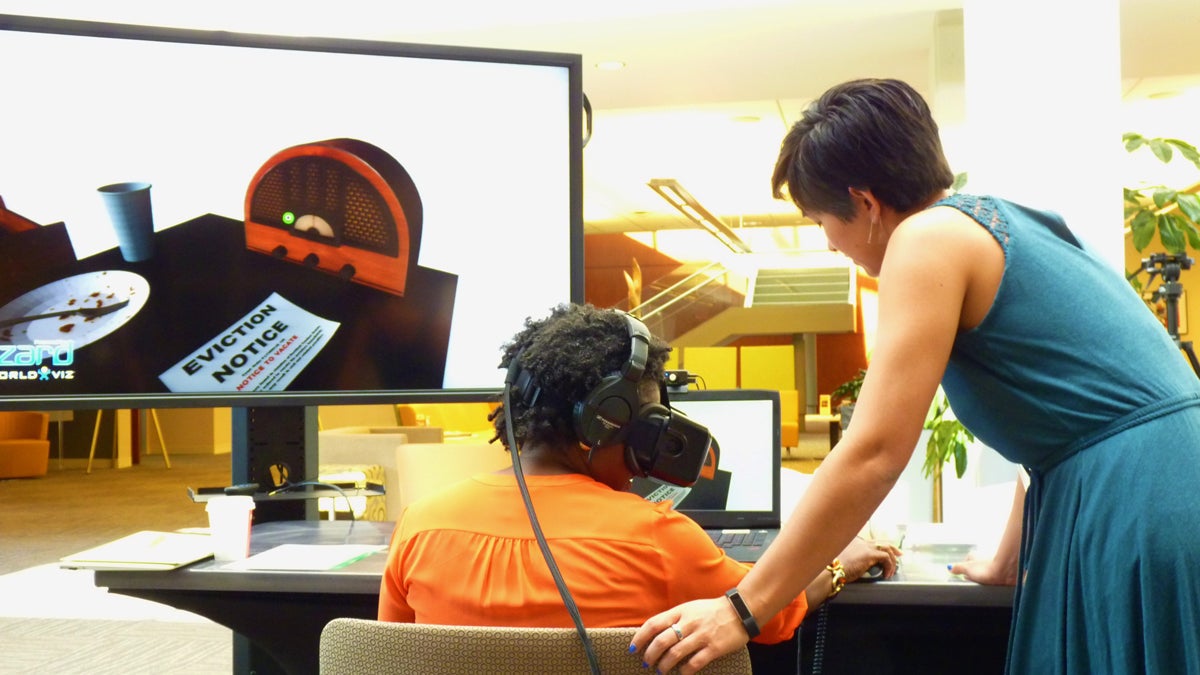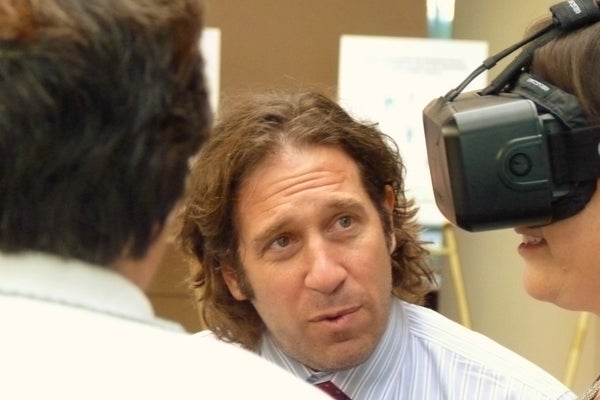Can virtual reality make us kinder?
Listen
Vanessa Farrell, a program associate at the Robert Wood Johnson Foundation, tries out an empathy-aimed virtual reality experience. Elise Ogle, from Stanford’s Virtual Human Interaction Lab, helped design the program. (Todd Bookman/WHYY)
Researchers are looking into VR’s empathetic potential.
Slip on the virtual reality headset, a sort of ski-goggles with power cord, and the first thing you see is an apartment. A crummy apartment with crummy furniture.
Then, through the earpiece, you hear a narrator explain that you’ve just been laid off, and need to sell the couch and TV or you can’t make rent.
Suddenly, the world shifts, and you are living in your car. You spin your head, and the virtual world spins with you. In the backseat, all your possessions are in a pile. Suddenly, in the driver’s window, there’s a flashlight. It’s a cop telling you you can’t sleep here.
On it goes, this first-person look at how someone, really anyone, can become homeless.
“We want to see if having this intense emotionally arousing experience could change the way you think and the way you act toward the homeless,” says Elise Ogle, project manager at Stanford University’s Virtual Human Interaction Lab, which designed this VR environment.
It’s one of a growing number of virtual reality worlds designed not for video gaming or entertainment, but rather to change human attitudes, and increase the user’s compassion and empathy. The concept is based on the Atticus Finch philosophy that the best way to understand someone else is to slip into their skin, and then walk around for a bit.
Jeremy Bailenson is the director of Stanford’s VHIL, which is researching these ‘social good’ experiences. He says the reason VR can work like this is because of its capacity for deep immersion. Put on the headset, and you get lost in a way you generally don’t when watching a movie or reading a book.
“The front of your brain tells you over and over again this is not real, it can’t be real,” he says. “But the back of your brain, the one that’s charged with basic survival, it can’t differentiate. And if it looks real, it if sounds real, it treats the experience as real.”
Bailenson’s lab is now embarking on its largest study of ‘social good’ virtual reality to date, something it’s calling Empathy at Scale. Using VR expriences, including the homelessness scenario, researchers hope to collect data from more than 1,000 participants, including tracking their empathetic reactions over time.
“How long do these effects last? Are they robust? Do they continue to produce attitude and behavior change six months out, or a year out? The truth is, we don’t know, and we hope to find out,” he says.

Jeremy Bailenson, who is at the forefront of ‘social good’ virtual reality research, shows off the technology. (Todd Bookman/WHYY)
The project is in part funded with a $300,000 grant from the Princeton, New Jersey-based Robert Wood Johnson Foundation, it’s first investment into how virtual reality may be able to improve public health and well-being.
“It’s undoubtedly going to lead to policies that can help support people who are in these situations, and just can also lead to all of us being kinder to our fellow man,” says Lori Melichar, a director at the RWJF.
At the University of Southern California’s Medical Virtual Reality Research Group, Dr. “Skip” Rizzo has also seen the empathetic benefits of these tools. He and his team designed a combat simulation to help soldiers battling post-traumatic stress disorder. But along the way, he realized the virtual reality experience could also benefit the soldier’s family.
“It kind of opens their eyes to what it was like for their loved one to have to go through a wartime conflict. When they are riding in a Humvee and all of a sudden an IED goes off…they have a little bit of a deeper sense of what their loved one has gone through,” says Rizzo.
You can read about the battle for Fallujah in the New York Times or watch the opening scene of Saving Private Ryan and get a feel for what war is like. But VR can potentially give a truer experience.
Exactly what that experience does for us, in terms of emotional processing, learning and behavior change isn’t yet fully understood.
“I mean, we’ve had, what, 100 years or so of psychology as a science, studying human behavior and interaction in the real world? Now we’ve got to spend a good bit of time studying how humans behave and interact in the virtual world,” says Rizzo.
Video games may still get most of the investment dollars, but there’s clearly a push to use this technology for social good.
The United Nations put money behind what’s perhaps the gold standard right now for this type of VR. It’s a short film called Clouds Over Sidra, about the life of a 12-year-old girl inside a Syrian refugee camp. That project’s director, artist Chris Milk, spoke about the potential for the technology during a TED Talk last year.
“So it is a machine, but through this machine we become more compassionate,” said Milk. “We become more empathetic. And we become more connected, and ultimately, we become more human.”
More human through shared experience, through stepping into someone else’s skin for a while.
It all sounds like fiction, but it feels like reality.
WHYY is your source for fact-based, in-depth journalism and information. As a nonprofit organization, we rely on financial support from readers like you. Please give today.



